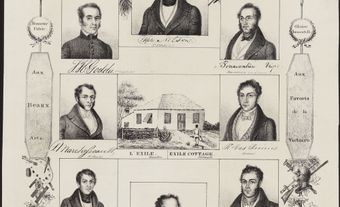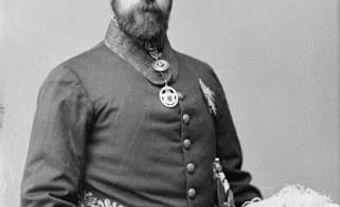This article was originally published in Maclean's Magazine on August 4, 1997
Versace's Killer Kills Self
In the end, Andrew Cunanan chose to go out the way he had lived: dramatic, elusive and in control. When he was discovered last week in a houseboat in Miami Beach - just 41 blocks from where he shot Gianni Versace dead and vaulted into instant notoriety - Cunanan did not hesitate. Reclining on two pillows in the second-floor master bedroom, his appearance altered yet again by a newly grown beard, and dressed only in grey boxer shorts, he put the barrel of his .40-calibre handgun in his mouth and pulled the trigger. In death, his face was so disfigured that it took police hours to finally confirm through a thumbprint that the body on the boat was indeed Cunanan's - and that his bizarre and largely unexplained killing spree was finally over.
Left behind were five families grieving for the victims he claimed in a deadly cross-country odyssey from Minneapolis to Miami. Also left was a string of unanswered questions. What started him killing, and why did he single out the men he shot, bludgeoned and stabbed to death? And why did he target Versace, the celebrity designer whose murder turned Cunanan from someone known and feared mainly in America's gay communities into the most wanted killer in the world? Cunanan left no suicide note, and by week's end authorities had unearthed no convincing explanation for his actions. But the sense of relief was palpable, especially in Miami Beach. On the steps of Versace's opulent mansion, where he was shot twice in the head, there were still flowers and candles. But a passerby had added a morning-after edition of the Miami Herald with the blaring headline: "Manhunt ends." Beside it was scribbled, "Debt settled."
Yet even near the end, Cunanan still hoped to elude the massive search for him. Within two days of Versace's death on July 15, Cunanan telephoned what police called only an "associate" on the West Coast, trying to find ways to obtain a fake passport and flee the United States. But there was no escape. Forced by intense publicity to hide out, Cunanan remained on the houseboat until luck turned against him. The boat's caretaker, Fernando Carreira, dropped by last Wednesday afternoon and noticed that a door was ajar. He looked inside and saw slippers and a pillow on the floor - evidence that someone had been using the vacant floating house, moored in a palm-shaded waterway called Indian Creek. Almost immediately, Carreira heard a gunshot and alerted police to an intruder. Police surrounded the craft for four hours, entering gingerly. Inside, they found Cunanan, dead by his own hand at the age of 27.
The lack of firm answers about Cunanan did not stop the experts from venturing their own explanations. Police, unsurprisingly, credited their intense manhunt for keeping Cunanan close to the scene of his last murder. He was, said Miami Beach police Chief Richard Barreto, "a desperate person with very little room to move about." James Fox, a criminologist at Northeastern University in Boston and a noted expert on multiple murderers, said the way Cunanan chose to avoid capture and punishment fitted his dramatic, manipulative personality. "He was still calling the shots, literally and figuratively," said Fox. "He maintained control to the end. He became his own executioner, rather than the state of Florida."
Police were able to piece together more details of Cunanan's final weeks, starting in late April when he left his home in San Diego and travelled to Minneapolis, where he claimed his first victim, a former lover named Jeffrey Trail. Cunanan, they said, may have started dealing drugs in San Diego as his life as a gay gigolo living off wealthy older men apparently fell apart. He may have tried to convince Trail to join him in the drug trade, and killed him when his onetime friend refused. Four other murders followed - in rural Minnesota, Chicago, New Jersey and, finally, Miami.
Along the way, Cunanan scattered clues to his passage - abandoned cars, a trail of phone messages. The FBI put him on its Ten Most Wanted list on June 10, but Miami police failed to locate him during the two months he spent in the area before attacking Versace, despite several sightings by people in the South Beach neighborhood. Most glaringly, they overlooked a form sent to the Miami Beach police department by a local pawn shop after Cunanan hocked a rare coin for $260. He signed the form with his real name on July 7 - but the information was not entered into police computers until the day Versace was shot. The miscues left some gay activists complaining that until Versace's high-profile murder, police did not take Cunanan's killing spree as seriously as they should have. Cunanan's first two victims were gay, as was he, went the logic, so the killer could be written off as someone preying only on a still-marginalized community. Police rejected that claim, arguing that they were hunting for Cunanan intensively well before Versace's death, and popular TV programs like America's Most Wanted publicized their search.
Others said that news coverage focusing on the most lurid aspects of Cunanan's spree - homosexual prostitution, sadomasochistic sex, cross-dressing and a suggestion of AIDS - once again brought out old stereotypes about gay men. "Here we go again, describing gay bars as dark and seedy, like we're some sort of Masonic group plotting and planning and doing weird rituals," said Eugene Patron, who writes a column about gay issues for the Miami Herald. "That's the problem: are we ever going to be perceived as productive members of society or are we going to be seen as a liability?"
With Cunanan dead, police turned to filling in the many gaps in his story. They still want to know why he singled out Versace, and whether the two men had any previous connection. And they want to know whether anyone helped Cunanan in his final days. In Las Vegas, they questioned Torsten Reineck, the 49-year-old German businessman who owns the houseboat where Cunanan hid out. They were hoping Reineck could explain why Cunanan sought refuge in his house. Even if there was no link between the two men, Cunanan's death brought bad news for Reineck. He, it turned out, is himself a fugitive from justice. Since 1992, he has been wanted on a Europe-wide arrest warrant arising out of fraud and tax evasion charges connected with businesses he once ran in Leipzig, Germany. Last week, too, Vancouver police confirmed that Cunanan spent several months there in the summer of 1996, but they said he was not linked to any unsolved murders.
Others are also keen to chart the saga of Cunanan and Versace. A London publisher commissioned a biography of Versace only days after the designer's death, and at least two books about Cunanan are in the works. The young man who craved attention in life, it seems, will get even more in death.
Maclean's August 4, 1997

 Share on Facebook
Share on Facebook Share on X
Share on X Share by Email
Share by Email Share on Google Classroom
Share on Google Classroom


